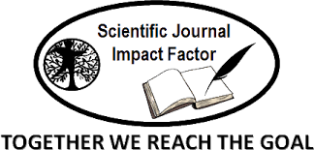Investigate the Operating Temperature Effect on Fast Pyrolysis Products of Food Waste with Hydrogen
Keywords:
Food waste, Fast pyrolysis, Hydrogen, Gaseous Products, yield %Abstract
Energy crises and environmental pollution are the main issues of concern all over the world and the disposal of wastes by converting into gaseous products can reduce this to a level. Investigating how operating temperature affects the yield and makeup of bio-oil, bio-char, and bio-gas during the pyrolysis process in the presence of hydrogen is the goal of this study. By offering a novel method for enhancing the quality and yield of gaseous products through controlled thermal decomposition in a hydrogen-enriched environment, the findings improve sustainable technologies. In this research, the fast pyrolysis of food waste carried out by using a lab scale fixed bed reactor in the presence of different composition of Nitrogen and Hydrogen to investigate the effect of operating parameters high pyrolysis temperature 600, 650, 700, 750 and 800 °C and hydrogen gas 0 %, 10 % and 20 % with Nitrogen as a carrier gas. The gaseous products maximum yield i.e. 45.68 comes out at 750 °C temperature in the presence of 10 % hydrogen. The results indicate that increasing the pyrolysis temperature boosts decomposition reactions, encouraging the formation of gaseous products. Hydrogen plays a crucial role by facilitating cracking and stabilizing the reaction intermediates, minimizing the formation of heavier components. The results demonstrate that the fast pyrolysis of food waste give residue at high temperature and in the presence of hydrogen up to 10 % achieved a maximum the bio gas yield. Energy crises and environmental pollution are major global concerns. Converting waste into gaseous products can help address these issues. This study examines how operating temperature influences the yield and composition of bio-oil, bio-char, and bio-gas during pyrolysis in a hydrogen-rich environment. By introducing a novel approach to enhance the quality and yield of gaseous products through controlled thermal decomposition, the findings contribute to sustainable technologies. The research involves fast pyrolysis of food waste using a lab-scale fixed-bed reactor, with varying nitrogen and hydrogen compositions. The effects of different operating parameters were analyzed, including high pyrolysis temperatures (600, 650, 700, 750, and 800 °C) and hydrogen concentrations (0%, 10%, and 20%), with nitrogen as the carrier gas.
The highest gas yield (45.68%) was achieved at 750 °C in the presence of 10% hydrogen. The results show that increasing pyrolysis temperature enhances decomposition reactions, leading to higher gas production. Hydrogen plays a key role by promoting cracking reactions and stabilizing reaction intermediates, reducing the formation of heavier byproducts. The study demonstrates that fast pyrolysis of food waste at high temperatures, with up to 10% hydrogen, results in the highest bio-gas yield.
References
R. H. Venderbosch, B. T. G. Biomass, and T. Group, “Fast pyrolysis technology,” no. 1, pp. 178–208, 2010, doi: 10.1002/bbb.
Z. Qi, “Review of biomass pyrolysis oil properties and upgrading research,” vol. 48, pp. 87–92, 2007, doi: 10.1016/j.enconman.2006.05.010.
T. Makov, A. Shepon, J. Krones, and M. Chertow, “Social and environmental analysis of food waste abatement via the peer-to-peer sharing economy,” Nat. Commun., no. 2020, doi: 10.1038/s41467-020-14899-5.
F. Girotto, L. Alibardi, and R. Cossu, “Food waste generation and industrial uses : A review,” Waste Manag., vol. 45, pp. 32–41, 2015, doi: 10.1016/j.wasman.2015.06.008.
J. Jo, S. Kim, J. Shim, and Y. Lee, “Pyrolysis Characteristics and Kinetics of Food Wastes,” 2017, doi: 10.3390/en10081191.
M. N. Uddin, K. Techato, J. Taweekun, and M. Rahman, “An Overview of Recent Developments in Biomass Pyrolysis Technologies,” 2018, doi: 10.3390/en11113115.
X. Huang, Z. Wang, and A. Ding, “Impact of Aerosol-PBL Interaction on Haze
Pollution: Multiyear Observational Evidences in North China,” Geophys. Res. Lett., vol. 45, no. 16, pp. 8596–8603, 2018, doi: 10.1029/2018GL079239.
J. Zhang et al., “Carbon science in 2016: Status, challenges and perspectives,” Carbon N. Y., vol. 98, pp. 708–732, 2016, doi: 10.1016/j.carbon.2015.11.060.
S. Y. Lee, R. Sankaran, K. W. Chew, C. H. Tan, and R. Krishnamoorthy, “BMC Energy Waste to bioenergy : a review on the recent conversion technologies,” pp. 1–22, 2019.
N. Krishnamoorthy, C. Nzediegwu, X. Mao, H. Zeng, B. Paramasivan, and S. X. Chang, “Biochar seeding properties affect struvite crystallization for soil application,” Soil Environ. Heal., vol. 1, no. 2, p. 100015, 2023, doi: 10.1016/j.seh.2023.100015.
A. K. Chakraborty et al., “Fabrication of visible-light induced fluorine doped bismuth oxide (Bi2O3-xFx) photocatalyst in degrading textile dyes from wastewater,” Chem. Inorg. Mater., vol. 1, no. September, p. 100019, 2023, doi: 10.1016/j.cinorg.2023.100019.
M. A. Naeem, “Food waste : causes and economic losses estimation at household level in Pakistan,” pp. 1–17, 2022.
Y. Song et al., “Multifunctional bismuth oxychloride/mesoporous silica composites for photocatalysis, antibacterial test, and simultaneous stripping analysis of heavy metals,” ACS Omega, vol. 3, no. 1, pp. 973–981, 2018, doi: 10.1021/acsomega.7b01590.
A. V Bridgwater, “Review of fast pyrolysis of biomass and product upgrading,” Biomass and Bioenergy, vol. 38, pp. 68–94, 2011, doi: 10.1016/j.biombioe.2011.01.048.
B. Biswas, N. Pandey, Y. Bisht, R. Singh, J. Kumar, and T. Bhaskar, “Pyrolysis of agricultural biomass residues: Comparative study of corn cob, wheat straw, rice straw and rice husk,” Bioresour. Technol., vol. 237, pp. 57–63, 2017, doi: 10.1016/j.biortech.2017.02.046.
K. M. Isa, S. Daud, N. Hamidin, K. Ismail, S. A. Saad, and F. H. Kasim,
“Thermogravimetric analysis and the optimisation of bio-oil yield from fixed-bed
pyrolysis of rice husk using response surface methodology (RSM),” Ind. Crops Prod., vol. 33, no. 2, pp. 481–487, 2011, doi: 10.1016/j.indcrop.2010.10.024.
A. S. Paul, N. L. Panwar, B. L. Salvi, S. Jain, and D. Sharma, “Experimental
investigation on the production of bio-oil from wheat straw,” Energy Sources, Part A Recover. Util. Environ. Eff., vol. 00, no. 00, pp. 1–16, 2020, doi: 10.1080/15567036.2020.1779416.
I. I. Ahmed and A. K. Gupta, “Pyrolysis and gasification of food waste: Syngas
characteristics and char gasification kinetics,” Appl. Energy, vol. 87, no. 1, pp. 101–108, 2010, doi: 10.1016/j.apenergy.2009.08.032.
G. Bensidhom, M. Sghairoun, K. Alper, and I. Trabelsi, “Fruit stalks pruning,” pp. 1561–1563, 2018.
D. Chen, L. Yin, H. Wang, and P. He, “Pyrolysis technologies for municipal solid waste : A review,” Waste Manag., vol. 34, no. 12, pp. 2466–2486, 2014, doi: 10.1016/j.wasman.2014.08.004.
B. Grycová, I. Koutník, and A. Pryszcz, “Pyrolysis process for the treatment of food waste,” Bioresour. Technol., vol. 218, pp. 1203–1207, 2016, doi: 10.1016/j.biortech.2016.07.064.
B. R. Patra, S. Nanda, A. K. Dalai, and V. Meda, “Slow pyrolysis of agro-food wastes and physicochemical characterization of biofuel products,” Chemosphere, vol. 285, no. May, p. 131431, 2021, doi: 10.1016/j.chemosphere.2021.131431.
M. F. Demirbas, M. Balat, and H. Balat, “Potential contribution of biomass to the
sustainable energy development,” Energy Convers. Manag., vol. 50, no. 7, pp. 1746–1760, 2009, doi: 10.1016/j.enconman.2009.03.013.
S. Pradhan, B. Yuzer, Y. Bicer, G. McKay, and T. Al-Ansari, “Hydrogen gas and
biochar production from kitchen food waste through dark fermentation and pyrolysis,” Front. Chem. Eng., vol. 6, no. November, pp. 1–10, 2024, doi: 10.3389/fceng.2024.1450151.

Downloads
Published
How to Cite
Issue
Section
License
Copyright (c) 2025 50sea

This work is licensed under a Creative Commons Attribution 4.0 International License.




















